Archived Blog Posts
6 Essential Tips for Protecting Your Building from Flood Damage
6/10/2023 (Permalink)
Floods can happen unexpectedly and cause significant damage to your building. Not only can they damage your property, but they can also disrupt your daily operations, leading to lost revenue and productivity. That's why it's important to take steps to protect your building from flood damage. In this blog post, we'll discuss some tips on how to protect your building from flood damage.
Conduct a Flood Risk Assessment
Before taking any preventative measures, it's important to understand the flood risk of your building. A flood risk assessment can help identify areas of your building that are at risk of flooding. This can include low-lying areas, basements, and areas near rivers or other bodies of water. Understanding the flood risk of your building can help you develop a flood protection plan that is tailored to your specific needs.
Install Flood Barriers
Flood barriers are a great way to prevent flood water from entering your building. These barriers can be made from a variety of materials, including sandbags, plastic sheeting, and flood panels. The type of flood barrier you choose will depend on the size of your building and the level of flood risk. For maximum protection, consider installing permanent flood barriers that can be easily deployed in the event of a flood.
Seal Your Building
Sealing your building can help prevent water from seeping in through cracks and gaps. This can be done by sealing doors and windows with waterproof sealant and installing weather stripping around the perimeter of the building. You should also consider installing backflow prevention devices on your plumbing to prevent sewage backup in the event of a flood.
Elevate Critical Equipment
Elevating critical equipment, such as HVAC units and electrical panels, can help prevent damage in the event of a flood. These items should be located on higher floors or elevated platforms to protect them from floodwater.
Install Sump Pumps
Sump pumps are designed to remove water from basements and other low-lying areas of your building. They are a great way to prevent water from accumulating and causing damage. Be sure to have your sump pumps inspected regularly to ensure they are functioning properly.
Develop a Flood Plan
Having a flood plan in place can help minimize damage in the event of a flood. Your flood plan should include evacuation routes, emergency contact information, and a plan for shutting off utilities. Be sure to communicate your flood plan to all employees and have regular practice drills.
In conclusion, protecting your building from flood damage requires a combination of preventative measures and planning. Conducting a flood risk assessment, installing flood barriers, sealing your building, elevating critical equipment, installing sump pumps, and developing a floodplain are all important steps in protecting your building from flood damage. By taking these steps, you can minimize damage and ensure that your business operations are not disrupted in the event of a flood.
SERVPRO'S 2023 Firefighter Challenge is in July!
6/6/2023 (Permalink)
 Support your local first responders this July during the SERVPRO Firefighters Challenge at Murray Park!
Support your local first responders this July during the SERVPRO Firefighters Challenge at Murray Park!
Who will bring the Best of Utah 2023 trophy back to their station this year? We'll find out on July 19-22nd, when Utah's best firefighters will bring the heat at this year's SERVPRO Firefighter Challenge! It’s going to be an exciting and unforgettable event as we cheer on our brave firefighters in the Firefighter West Region Challenge at Murray Park.
As a title sponsor of the event, SERVPRO corporate and many SERVPRO’s in Utah came together to sponsor a Make-A-Wish child and grant them their wish! The Make-A-Wish Foundation is the beneficiary for the Firefighter Challenge. As part of the sponsoring SERVPRO's, SERVPRO of St. George is excited to celebrate our local first responders!
During this event, firefighters from all over Utah will display true bravery and teamwork in the SERVPRO Firefighter Challenge. This challenge includes a set of obstacles specifically made for firefighters. These firefighters wear their full protective gear, use their tools and compete to be the quickest and most thorough firefighters in Utah! Come witness their determination and courage as they battle for the trophy.
We are currently preparing for the event and looking for volunteers to help make this weekend a success! Click the link here to register: https://www.signupgenius.com/go/9040e4aada922aa8-SERVPRO#/
We can’t wait to come together to support and honor local heroes as we cheer them on to victory!
Does Renters Insurance Cover Mold Damage? Everything You Need to Know
5/17/2023 (Permalink)
As a renter, you may wonder if your renters insurance covers mold damage. Mold is a common problem that can occur in homes and apartments, and it can cause significant damage to your personal belongings and the property itself. In this blog post, we will explore whether renters insurance covers mold damage, what types of mold damage are covered, and how to file a claim for mold damage.
Does renters insurance cover mold damage?
In general, most renters insurance policies do not cover mold damage. However, there are some exceptions. Some policies may cover mold damage if it is a result of a covered peril, such as water damage from a burst pipe or a natural disaster. It's important to review your policy carefully to understand what types of mold damage are covered and what types of damage are excluded.
Types of mold damage covered by renters insurance
If your renters insurance policy does cover mold damage, it will typically only cover certain types of mold damage. For example, if the mold damage is a result of a covered peril, such as water damage from a burst pipe, then the mold damage may be covered. Additionally, if the mold damage is a result of a sudden and accidental event, such as a roof leak or a plumbing problem, then it may be covered.
Types of mold damage not covered by renters insurance
Most renters insurance policies do not cover mold damage that is a result of long-term neglect or lack of maintenance. For example, if you fail to report a leaky faucet or a roof leak, and the mold damage results from this negligence, then it is unlikely that your renters insurance policy will cover the damage. Additionally, if the mold damage is a result of a flood, it may not be covered unless you have separate flood insurance.
How to file a claim for mold damage
If you experience mold damage and believe that it is covered by your renters insurance policy, it's important to file a claim as soon as possible. Here are the steps you should take:
- Contact your insurance company: Call your insurance company as soon as possible to report the mold damage.
- Document the damage: Take photos and videos of the mold damage, as well as any other damage that may be related to the mold.
- Provide proof of ownership: Provide your insurance company with a list of your damaged property and proof of ownership, such as receipts or photos.
- Cooperate with the investigation: Your insurance company may send an adjuster to investigate the mold damage. Cooperate with the investigation and provide any information or documentation requested.
- Follow up on the claim: Keep track of the status of your claim and follow up with your insurance company as needed.
Understanding Renters Insurance Coverage for Mold Damage
In conclusion, renters insurance policies typically do not cover mold damage, but there may be exceptions. It's important to review your policy carefully and understand what types of mold damage are covered and what types of damage are excluded. If you experience mold damage, it's important to file a claim as soon as possible and provide all necessary documentation to support your claim. By taking these steps, you can help ensure that your mold damage claim is processed quickly and efficiently.
Fire Safety: Immediate Steps to take after a fire
5/1/2023 (Permalink)
Fire safety is a serious concern. Fires can be frightening, and they can also cause damage to your building that can make it unsafe or uninhabitable. If you've experienced a fire in your building, you may want to take steps to ensure that it doesn't happen again.
In this guide we'll talk about some of the dangers of fires (and how they can impact you), what to do if there's been a fire in your building, and how to keep yourself safe from future fires by making sure all of the proper precautions are taken by everyone involved with maintaining the structure itself--from contractors who work on renovations or repairs through tenants who use space within each floor plan unit itself.
Immediate Steps After a Fire
- Call the fire department and report the blaze.
- Contact your insurance company to file a claim and get help with cleanup.
- Contact a fire damage restoration service to begin repairing damages caused by smoke, heat and water infiltration.
Assessing the Damage
After a fire, it's important to assess the damage and make sure your building is safe. Here are some tips for assessing structural damage:
- Look for buckling or sagging floors and walls. If you see any of these signs, call an engineer to come inspect your building.
- Check for water damage by looking at baseboards and other areas where water could have seeped in through cracks in windows or doors.
Repairing the Damage
After the fire, you will need to hire a fire damage restoration company to repair your building. The experts can replace damaged building materials and repair electrical and plumbing systems so they are safe for use again.
The best way to prevent this type of damage is by having regular inspections performed on your property by professionals who know what they are looking for when it comes to potential hazards like electrical issues or faulty wiring in a room where flammable liquids are stored.
Preventing Future Fires
- Install smoke detectors. The National Fire Protection Association (NFPA) recommends that you install at least one smoke detector on every floor of your home, including the basement and attic. If you have an older home with no existing wiring for electric or battery-operated detectors, consider installing hardwired versions instead.
- Consider installing fire extinguishers in key locations throughout your building. While it's important to have a fire extinguisher handy in case of an emergency, they're also useful tools for preventing fires from starting in the first place: if someone accidentally leaves a candle burning unattended or forgets about a pot on the stovetop, having an extinguisher nearby can help prevent serious damage from occurring before anyone notices there's been an accident at all!
Protecting against Natural Disaster
- Secure the building's roof.
- Reinforce the building's foundation.
- Install storm shutters or other protective measures to keep out wind and rain damage, as well as debris that could cause injury if it were to fly through your windows during a storm or hurricane.
Conclusion
Secure the building to prevent future fires. Follow safety practices to keep your employees and customers safe, including using fire extinguishers to put out small fires before they spread to other areas of the building. Making sure that all electrical wiring is up to code and in good condition so it can't cause an electrical fire or malfunction that could lead to a fire (such as overheating). Ensuring that there are no combustible materials near heating units or other sources of heat, such as stoves or ovens--and if there are, removing them immediately!
How do you keep pipes from freezing?
3/15/2023 (Permalink)
Frozen pipes can cause damage to your home, and they can also lead to expensive repairs. The best way to prevent frozen pipes is to take precautions during winter months. You may not be able to prevent all freezing, but you can minimize damage.
Take precautions during winter months.
Taking precautions during the winter months can help reduce pipe breaks when the weather starts to warm up. Keeping all unneeded rooms doors closed to keep rooms warm.
Don't leave faucets running for long periods of time--even if you're not using much water at all! Running water causes excess condensation that can freeze inside pipes and cause them to burst when temperatures drop overnight or during cold snaps in springtime.
Avoid using heating pads on pipes--they're notorious for causing damage! If you must use one around your plumbing system, make sure it's only on low settings so as not to overheat anything near where they're located. Also keep an eye out for signs of melting plastic or rubber seals around where these devices are placed because they could leak into other areas nearby if left unattended long enough.
Insulate pipes and keep wrapped in foam or other insulating material.
Use a heat tape to keep pipes warm, especially if you don't have central heating. The best way to do this is to wrap the tape around your main water pipe line, which runs through the basement and into your home's walls or crawlspace. Heat tapes can be purchased online or at hardware stores, but installation requires some DIY skills and may require hiring an electrician if you're unsure of what you're getting into.
Use a thermostat-controlled switch to turn off power when temperatures drop below freezing outside so that no heat is wasted inside your home on non-essential items such as lights, televisions and computers and thus lessening their impact on heating costs.
Turn down the heat thermostat on your water heater
Turn down the heat thermostat on your water heater so it will not be as cold when it is turned on. This can help reduce the chance that water in pipes will freeze and burst.
How do you turn down a thermostat? If your water heater has an adjustable dial, turn it to a lower setting (between 120 degrees F and 125 degrees F). If not, contact a professional plumber who can adjust or replace the unit with one that has an adjustable thermostat control. If your existing unit is already frozen, call SERVPRO for your emergency plumbing service immediately.
You can take steps to prevent frozen pipes and minimize damage if they do freeze. The best way to prevent frozen pipes is by taking precautions during winter months. You may not be able to prevent all freezing, but you can minimize damage by following these steps. Give SERVPRO of St. George a call today!
Do I Need A Sump Pump?
2/13/2023 (Permalink)
Sump pumps are a common sight in basements and crawl spaces, but you may not realize what they do or why you need one. A sump pump is a device that uses water pressure to remove excess liquid from the bottom of a basement or crawl space. This prevents flooding by pushing water back up through drainage pipes, preventing it from pooling in your foundation and causing damage to your property.
Sump pumps prevent water damage in your basement
Sump pumps are a common device found in basements. They remove water from the basement and keep it dry. Sump pits are holes in the ground or pavement of your property, which is typically designed to collect rainwater runoff and prevent it from seeping into your home. When sump pumps are installed, they draw this water out of the basement and drain it into an outside drain system or stormwater drainage system.
Sump pumps should be replaced if they fail to work properly, if they are not regularly maintained or cleaned out (if necessary), or if there has been any physical damage sustained during the installation or operation of your sump pump system.
Most basements will need a sump pump
Most basement owners will find that they need a sump pump. With that said, it's not a given that every basement will require one. A sump pump is helpful in preventing water damage and mold growth in your home. However, it isn't always necessary if you have an exterior drainage system.
Sump pumps can be expensive and difficult to install, especially for the DIYer who doesn't have much experience working with electrical systems or plumbing. It is always best to rely on a professional when it comes to sump pump installation and maintenance.
How long do sump pumps last?
The life of a sump pump depends on the type of pump and how it is used. The average lifespan of a sump pump is roughly ten years, though they may last longer if they are properly maintained.
Sump pump maintenance tips
Sump pump maintenance is often overlooked, but it can prolong the lifespan of your sump pump. Proper maintenance should be performed at least every 3 months:
- Clean the sump pump screen every 3 months.
- Remove any debris caught in the sump pit and ensure that you don’t have any rust or corrosion on it; replace it if necessary.
- Remove the sump pump from the pit once a year a perform a thorough cleaning.
Sump pumps can save you a lot of time and money by keeping water out of your basement. The best part is that they don't require much maintenance so it's easy to keep them working properly! If your sump pump fails and it results in water damage on your property, don't hesitate and give our SERVPRO of St. George team a call today!
Everything You Need to Know About Smoke Damage
1/19/2023 (Permalink)
Smoke damage can be a serious problem. It's often more extensive than you think, and it can happen to even the best-protected homes. This guide will help you recognize the signs of smoke damage, understand how it affects your property, and learn what steps to take after suffering from smoke damage.
Smoke damage can be obvious or subtle.
Smoke damage can be obvious or subtle. The lingering smell of smoke is often the first sign, but sometimes there are no smells at all—the damage tends to occur behind the scenes. Smoke from cooking accidents and cigarettes can cause significant damage too, so even if you don't smell anything out of the ordinary, it's important to check for signs of smoke damage in your home or office space.
Smoke-damaged property may have any number of telltale signs:
- A coating on the walls and ceiling that resembles white paint
- Discoloration on walls, ceilings, and furnishings
- Soot webs on the ceilings and walls
Understanding smoke damage.
Smoke damage is perhaps one of the most difficult types of damage to deal with, and can cause your property to be unsaleable if not handled properly. Not only does smoke damage need special attention in order to get rid of it, but even after cleaning it may still be present in some form.
If a fire has caused smoke damage to your property, it's time for some remediation. Smoke and soot are extremely corrosive to many surfaces, including wood, drywall, carpet, and fabric. In addition to discoloring walls and floors, smoke can also leave behind an unpleasant odor that can permeate the air for months after the fire is extinguished. Although you may be tempted to just cover up the smell with perfumes or room sprays, they won't be nearly as effective as professional cleaning services—and they'll only mask the problem temporarily at best.
Smoke odors are extremely stubborn and tend to linger for months or even years after a fire has occurred. In addition, smoke can cause permanent discoloration along surfaces such as walls and ceilings that will require repainting or covering up with new drywall.
It is dangerous to clean up from a fire without professional help.
It's important to understand that if you attempt to clean up from a fire without professional help, you can be exposed to harmful chemicals and toxins. You may be injured by sharp objects that have been burned and are now sharp, such as glass or metal. You could even be exposed to asbestos, lead or mold if the material was present in the home before the fire occurred.
Do not try to clean up after a fire yourself, call your local SERVPRO experts for assistance today!
Smoke damage can be a big problem, with serious consequences for your home and family. If you've found yourself facing this problem, don't panic! It's important to remember that there are resources out there for people who have encountered smoke damage in their homes. Our SERVPRO of St. George team is always on standby and ready to respond to your fire, smoke, and soot damage!
Tips for Protecting Your Valuables from Fire
12/20/2022 (Permalink)
Tips for Protecting Your Valuables from Fire
Fires are a serious threat to homes, businesses, and lives. They can be started by anything from faulty wiring to cooking mishaps—and if your home is damaged by fire, you're at risk of losing some of your most valuable possessions. To protect against this possibility, start with these tips:
Use Fireproof Storage
If you have valuables that you'd like to keep safe, store them in a place that is fireproof. Fireproof containers are made of metal or concrete and are rated for a specific temperature. Make sure to read the rating before buying one, because it will tell you how hot the container can withstand before it melts or explodes. You can find these containers at most hardware stores and online retailers like Amazon.
You should invest in a quality safe that can withstand fire, water, and theft. Safes are typically made out of metal or concrete to protect the valuables inside. Most safes also have an electronic locking system for added security.
When it comes to choosing the right size and type of safe, consider what you will be storing in it. For example, if you want to store documents such as passports and birth certificates then an all-metal fireproof document safe would be ideal because these items cannot stand up to water damage. If your valuables include jewelry and other precious metals then a combination lock safe is best because they are both waterproof and theft-proof while still meeting fire safety standards
Install Smoke Alarms
The most important way to protect your valuables is to install smoke alarms. These are devices that detect smoke and fire, alerting you to the danger so that you can act quickly. Smoke alarms should be placed on every level of your home, including the basement. Follow these steps:
- Read the instructions on how to install your new smoke alarm.
- Slide up or pull off any face plate on your current unit that covers a screw hole in order to access it, then replace it after installing the new unit (or remove it if no such plate exists).
- Turn off power at circuit breakers before doing anything else, unless you have a hardwired system with battery backup; if this is what you have installed in your home, proceed when ready.
Protecting the Whole Home
You can make your home more fireproof by installing smoke detectors, testing them regularly, and keeping fire extinguishers within easy reach. Smoke detectors should be installed on every floor of your house and near sleeping areas. Test them once a month by pressing the test button or pulling the pin.
Fire extinguishers should be placed in easily accessible areas like kitchens and hallways; they should also be labeled according to their contents so that everyone knows what type of fire they will put out (e.g., standard ABC extinguisher for paper fires). If you have any questions about how to use them, consult an expert at your local hardware store.
Finally, create a fire escape plan: designate two exits from every room so that everyone knows where they're going if there's an emergency; practice this plan regularly so everyone remembers it even when stressed out by danger.
Review Your Plan with Your Family Often
It’s important to review your family’s fire safety plan with them often. A fire safety plan is a map of your house that shows the locations of all exits, where you would meet after escaping and any other important information you would need in an emergency. Your plan should also be reviewed by everyone who lives or spends time at your home, including friends and relatives. As we age and our physical abilities change, it may be necessary to update an existing plan with new information about how best to get out if something goes wrong in a particular part of the house.
It’s also important that you practice your escape route regularly so that everyone knows what to do if there is ever an actual emergency (and even more importantly, so that everyone knows not to panic).
Taking precautions against fire will help you save what matters most to you.
Fire safety is important for everyone, especially if you have a family and/or valuables. It’s a good idea to review your fire safety plan regularly and practice it with your family so that everyone knows the steps to take in case of a fire.
We know that fires are scary, but we also know that you can protect your valuables from them. The best way to do this is by taking precautions and making smart decisions about where you store your things. If you follow these tips, then you’ll have a much easier time protecting yourself from a devastating fire—and hopefully, even prevent one altogether!
If your home catches on fire and you find you need some of your contents restored, call SERVPRO of St. George.
The Water Damage Restoration Process Explained
11/6/2022 (Permalink)
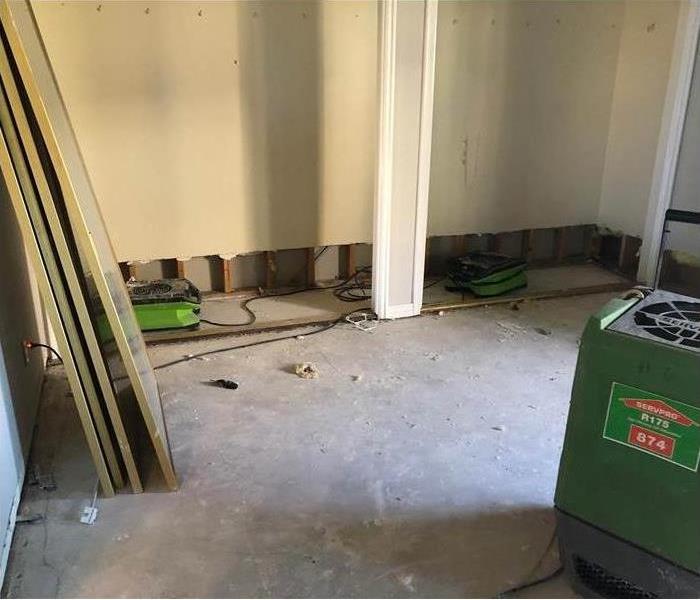 If you have water damage in your home call SERVPRO of St. George.
If you have water damage in your home call SERVPRO of St. George.
The Water Damage Restoration Process Explained
Water damage can be a frightening experience. There are many steps involved, which can be confusing if you're not familiar with the process. We've created this guide to help you understand what to expect during the water damage restoration process.
Contacting a Water Restoration Company
If you have water damage, the first thing to do is contact a water damage restoration company. You should ask for a free estimate. The person who gives you an estimate will want to know:
- how much water has gotten into your home or business
- how long the area was wet before it was discovered
- what caused the leak and where it occurred in your property's structure.
Ask about their experience with similar problems and how they will approach this one. It's also important to find out how long it will take for them to complete the job. Ask about their insurance coverage, as well as any certifications they have that relate specifically to water damage restoration work in your area.
Inspection and Evaluation
The first step in the water damage restoration process is an inspection and evaluation. The goal of this step is to determine the extent of damage and assess the extent of the damage. If you do, contact a company that specializes in water damage restoration, like SERVPRO of St. George. This will help them determine what type of equipment they’ll need and how long it will take for your home or business to be restored.
Once you have contacted them, they will come out to assess the situation. They may perform tests like taking moisture readings from different parts of the property so they can determine where exactly all this moisture is coming from. They will also take pictures throughout the entire process!
Water Removal
The next step in the water damage restoration process is to remove all of the water from a property. To do this, professionals will use a wet/dry vacuum for dry extraction or an industrial pump for extraction. The goal is to remove as much moisture as possible before any other steps in the process are taken.
The importance of removing all excess moisture from your property cannot be understated: not only does it prevent further damage, but it can also help prevent mold growth and ensure that your home doesn’t become uninhabitable due to unsafe conditions. For many people, water removal is often seen as being one of the most stressful parts of dealing with a flood or another type of spillage because there are so many factors involved.
Drying and Dehumidification
Next, you need to dry out and dehumidify the home to prevent mold growth. The longer you wait, the more likely mold growth will occur. If drying and dehumidifying are not completed in a timely manner, the structure of your home can be permanently damaged by water damage.
Once you have dried out the affected area, you will need to clean up all of the water that remains in it, even the moisture that has been absorbed into the floors, walls, and ceilings. This task is best left up to professionals who have experience dealing with water damage restoration so that they can properly dispose of any hazardous materials.
Cleaning and Repairing
After the water damage is thoroughly cleaned up, you need to make sure that the property is safe to occupy again. This can be challenging without the proper knowledge, equipment, and cleaning solutions. That’s why we use experienced and knowledgeable technicians who have been trained on how best to get your home back in shape before it’s too late.
When we finish with your property, it will look like nothing ever happened! You will be able to move back into your home with no worries whatsoever.
The water damage restoration process can be complicated. You’ve probably heard stories of homeowners going through this on their own, but they almost always end up making things worse if they don’t have the right equipment or know-how. It’s definitely worth it to call in the professionals when dealing with water damage because they know exactly what they’re doing and will handle everything from start to finish so you don't have to worry about anything else! If you need help with any of these steps, give our SERVPRO of St. George team a call today!
What should I look for in a fire restoration company
10/17/2022 (Permalink)
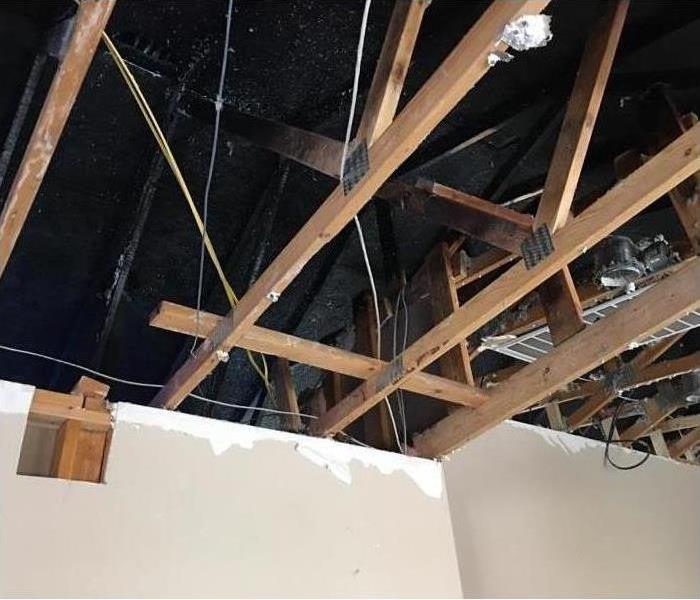 Fire damage is often overwhelming in its scope and severity, leaving you wondering how you will ever be able to get back on your feet again.
Fire damage is often overwhelming in its scope and severity, leaving you wondering how you will ever be able to get back on your feet again.
What Characteristics Should I Look For In A Fire Restoration Company?
We at SERVPRO of St. George know what it's like to lose a building due to fire. That's why we make sure our team is trained and equipped with the right tools to get the job done right the first time so you can get back to normal as soon as possible!
Why is there a need for fire restoration?
A fire can be a devastating event for any owner, and they may feel overwhelmed with the process of getting their home or business in St. George, UT, back to normal. Fire damage is often overwhelming in its scope and severity, leaving you wondering how you will ever be able to get back on your feet again. At times like these, it's good to know that there are professionals who specialize in dealing with such disasters who can help you during this difficult process.
What is so special about SERVPRO of St. George?
If you ever find yourself in a situation where your property has been damaged by fire, SERVPRO of St. George can help. We are certified fire damage restoration specialists and have years of experience restoring properties after they’ve been affected by fire. Our team knows how to handle everything from smoke and water damage to ash removal and much more. When it comes to restoring your home after a fire, we have the expertise that you need when looking for a trustworthy partner who understands exactly what needs to be done in order to get your space back into livable condition.
We understand that any type of structural damage can be stressful for homeowners—so let us take care of it! Call us today at (435) 656-9061 or inquire online so we can begin working on your property now!
When a building suffers a fire, we make sure the restoration is done right the first time.
When it comes to fire restoration, there are lots of things to consider. Whether your home or building has been damaged by a fire, water damage, or smoke damage we have the right equipment and training to do the job correctly. With our experience in this field, we know what to expect from a restoration project and how best to approach it. We also understand that every job is different and requires a unique solution tailored to the specific needs of each customer. For us, everything starts with attitude – an attitude that says, “No problem!”
As you can see, the fire restoration process is a long and complicated one. But SERVPRO of St. George will be there every step of the way to make sure that your home or business is restored properly and safely. We know it’s not easy being a homeowner or a small business owner, so we want to give you peace of mind when tragedy strikes. Our team is here to help get your life back on track as quickly and smoothly as possible. We have extensive experience in this field and want nothing more than for our customers to be happy with the work we do for them!
Developing a Fire Evacuation Plan
8/25/2022 (Permalink)
Creating An Evacuation Plan In The Event Of A Fire
As a homeowner and parent, you couldn’t bear the thought of a devastating fire threatening your kids’ safety or the security of your house and belongings. In the event of a fire, the most important thing you can do for your family is safely get everyone out. To avoid confusion and panic, it’s essential that you develop an escape plan so that if this terrible ordeal does occur, everyone will know what to do. There are some basic steps and components for evacuating if your Veyo,UT home is on fire.
Conduct a Thorough Walk-Through
You live in your home, but that doesn’t mean you shouldn’t become more familiar with the intricacies of the layout and places of exit. Take your family through your house to ensure everyone knows how to effectively take part in a fire escape.
- Inspect the windows and doors in every room.
- Make sure the windows open easily and that even younger family members can open them.
- Make sure there are at least two ways out of every room.
Pick a Gathering Place
Once everyone has safely escaped the home fire, you need a place to congregate. This should be a safe distance from the home, and it should be a place everyone is familiar with. Make sure everyone in your family knows the spot you’ve designated so there won’t be any mistakes about where you should go if a fire starts.
Practice the Escape
You hope to never have to put this escape plan in motion, but if you have to, you’ll be glad you’ve done a few run-throughs. Your kids’ safety is at stake, so make sure everyone has the process down well.
There’s nothing more important to you than your kids’ safety. If you prepare yourself and your family well, you can help minimize the chances of tragedy if a fire starts in your house.
5 Signs You Have Mold in Your Home
8/24/2022 (Permalink)
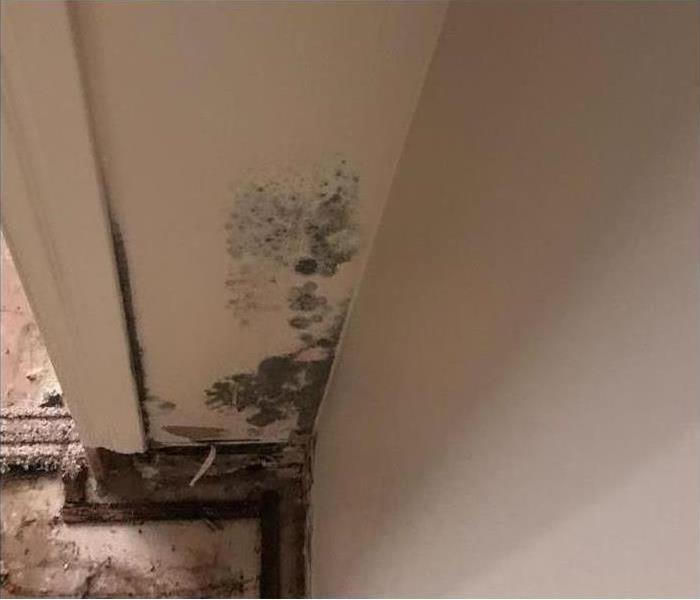 Mold damage in La Verkin, UT.
Mold damage in La Verkin, UT.
5 Signs You Have Mold in Your Home
Mold is a type of fungus that can grow in your home in La Verkin, UT. You can commonly find it around your bathrooms, basement, or near plumbing. Any indoor environmental specialist will tell you that it is a problem that you need to look for. Fortunately, there are several easy-to-spot signs of mold.
1. Odor
While not every type of mold produces an odor, most do. If you notice a musty or earthy smell in your home that won't go away with elbow grease, it is probably coming from hidden mold. Unfortunately, hidden mold typically must be removed by professionals.
2. Visible Growth
Sometimes you will see mold growing in white lines. Other times it will look like black spots. Still yet, you could see it as patches of gray, brown, black, green, pink, white, orange, or purple growth. Anytime you find large amounts of visible growth, you need to contact an indoor environmental specialist for a mold test.
3. Water Damage
Water damage is a big cause of mold. Any time you notice signs of water damage, like stains or discoloration, or bubbling paint, you are probably dealing with something that will cause mold.
4. Water Leaks
If you've recently had a water leak, you should be on the lookout for mold in the surrounding area. Even if you have it repaired quickly, spores can still sprout behind walls. When this happens, you will need to contact an indoor environmental specialist for their removal services.
5. Flooding
Mold can also pop up after flooding. If you've experienced flooding recently, chances are there is mold growing in your house.
Mold growth in your home is a problem that will often require removal by a mold remediation company. The key is to identify and treat it early on in the case. By watching for these characteristics, you can keep your home safe from this fungus.
When Should Pipe Break Damage Mitigation Start?
8/17/2022 (Permalink)
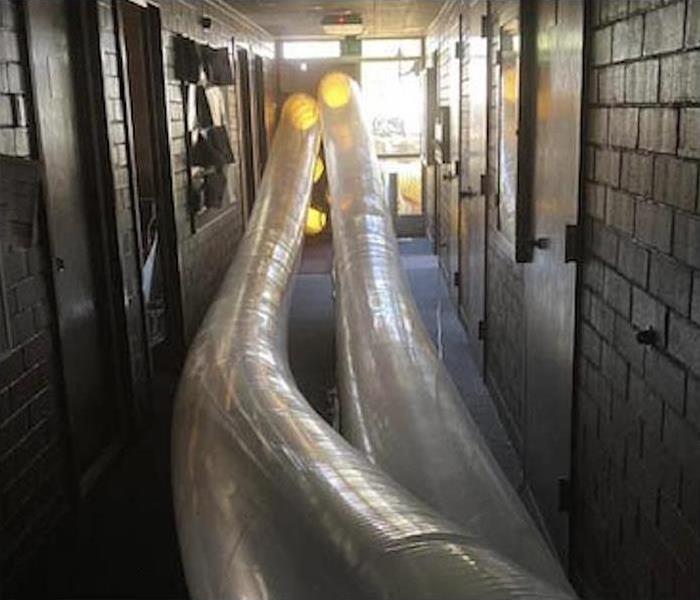 Commercial cleanup restoration
Commercial cleanup restoration
Take The Following Mitigation Measures When A Pipe Breaks
Restoration professionals use the term “mitigation” to describe measures that limit the severity of damage. Bursting pipes can release hundreds or thousands of gallons of water into a commercial structure in Hurricane, UT.
As Soon As a Break Is Evident
A building manager or owner should turn off the main water supply to stem the flow out of a broken pipe pouring or spraying water. Once this step has been taken, it may be possible to pursue any of the following measures:
- Collect water flow in containers
- Mop up standing water
- Extract water with a wet vacuum
Reducing the amount of water from bursting pipes that sinks into building materials and contents may limit the severity of damage. In general, clean water only requires timely extraction and drying.
Once the Flow Stops
Shutting off the water supply and gathering up water are both stopgaps. Once a licensed plumber arrives to fix broken pipe and restoration professionals assess and document damage, a building owner can have water pumped out and get the drying process underway within hours.
Over the Next 24 Hours
The primary goals of a property owner during the day after water damage occur involve removing standing water and drying any portion of a structure exposed to water damage. Restoration experts can recommend the best way to dry out a building with fans, industrial air movers, or dehumidifiers.
Bursting pipes are a common cause of property insurance claims. Water damage may cost as much as $10,000 to fix, depending on contamination level and whether building materials have been ruined and require replacement. Maintaining plumbing and arranging for timely mitigation of water damage are the best ways to keep water damage cleanup costs low at a commercial building in Hurricane, UT.
4 Ways To Prepare Your Business for a Thunderstorm
7/27/2022 (Permalink)
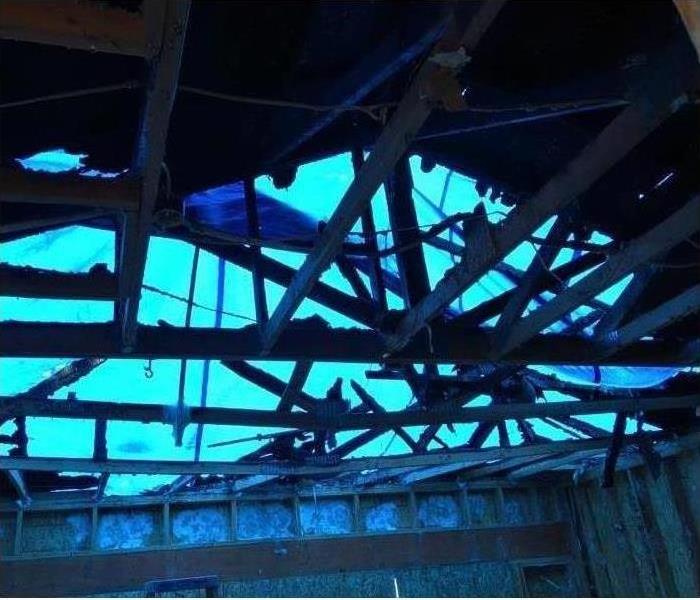 Roof damaged by high winds.
Roof damaged by high winds.
Prepare Your Business for a Thunderstorm
You're probably used to experiencing thunderstorms in your Hurricane, UT, business building. However, you may experience one or more that are potentially dangerous, possibly to the point of requiring storm damage restoration. If this occurs, you'll want to be ready. So, here are four ways to prepare your business for a thunderstorm.
1. Make a Safety Plan
One of the most important things to do in this process is to make a plan of action. First, start by conducting a walk-through of your building. You'll need to find places for everyone to go during a storm with high winds. Look for areas that are away from the following:
- Windows
- Highly breakable glass
- Skylights
Once these spots have been located, be sure to let your employees know about each one. If you can, you may want to create signage as a reminder.
2. Keep Trees Trimmed
Trees can be dangerous during a storm, especially if some aren't kept trimmed. If a strong enough wind blew during a rain storm, a tree or its branches could fall and cause significant damage to your building. Fortunately, trimming trees allows the plants to better resist the wind.
3. Use Lightning Rods
Lightning rods serve as protection for buildings from lightning strikes. Be sure to get these rods installed if your building doesn't have any. If you do have lightning rods, get each one inspected on a regular basis. You don't want your protection to stop working during a rain storm.
4. Learn First Aid
In the event that one of your colleagues is injured during a storm, you'll want to know first aid. Be sure that you or someone reliable on your staff is knowledgeable in this regard. You'll also want to have some backups in case that individual isn't present.
Preparing for a dangerous rain storm is an important task for any business owner. No matter how high or low your area's storm risk is, be sure to give the preparation process your full attention.
How to Remove Microwave Smells
7/20/2022 (Permalink)
A microwave oven, like any other kitchen appliance, needs to be cleaned regularly so that it continues to work well and lasts for a long time. If not maintained properly, it can emit a smoke smell or other unpleasant odor.
Cleaning the Filters
Most over-the-range units have two different filters that need to be cleaned or changed regularly.
Charcoal filter: This filter absorbs pollutants from the foods you cook on your stovetop. The filter is made up of tiny pores located on the surface that trap the toxins and smoke smell. Over time, the pores get filled up. When that happens the filter will need to be replaced. Most manufacturers recommend that you replace your charcoal filter every six months. If your over-the-range unit has vents that blow air directly to the outside of your home, however, the charcoal filter doesn’t need to be replaced because the air in the hood is not recirculating.
Grease filter: This filter should be cleaned out about once a month. Just soak it in hot water and detergent and then gently remove any debris with a soft brush. It’s important to remember to avoid using any cleaning products that contain ammonia. If you have questions about how frequently to clean the grease filter, refer to the owner’s manual.
General Cleaning: You should never allow food particles to build up on the inside walls of your unit. Wiping the walls down with warm water and dish detergent after each use will make it easier to keep the appliance clean. Crusted food is hard to remove and it may also prevent your unit from working properly. You should also keep the vent grill clean by wiping it gently with warm water and detergent regularly.
Your microwave is an important appliance in your kitchen in Enterprise, UT. Maintaining a simple cleaning routine will keep smoke smell at bay and also keep your unit working well for many years.
How Do Electronic Claims Services Work?
7/11/2022 (Permalink)
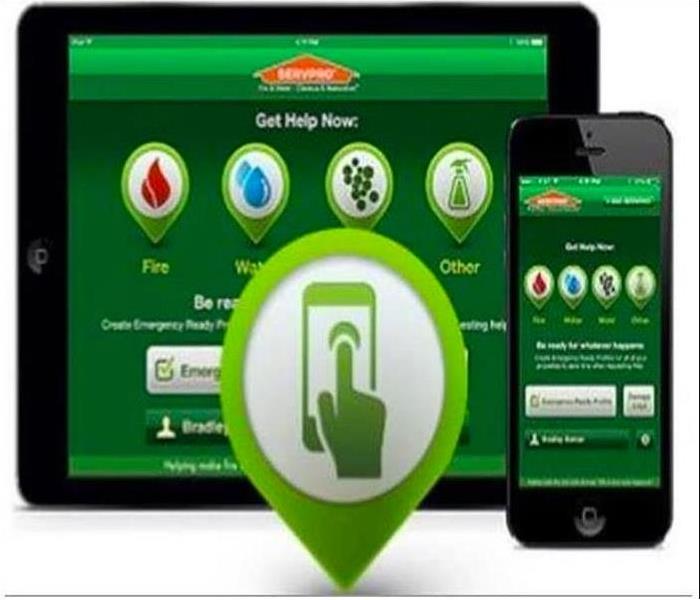 Insurers can rely on the electronic claims service used by the leading restoration company.
Insurers can rely on the electronic claims service used by the leading restoration company.
What Is the Process of Using Electronic Claims Services?
Shuffling papers is a relic of the past when it comes to making an insurance claim. Property owners, restoration professionals and insurance agents can all appreciate the efficiency of a fully digital electronic claims service. Find out how this type of service can impact every stage of the process of making a claim and getting coverage for damage to a property located in Veyo, UT.
Upload Damage Documentation
A local restoration franchise can send a team to a location within hours of a damage report. In situations involving larger losses, these specialists may arrive sooner than an insurance agent. All of the following information obtained through inspection and pretesting is made available to insurers through an electronic claims service:
- The first notice of loss
- Photographs of damage
- Forms and paperwork
- A detailed estimate
Insurance representatives can access this information online at their convenience. This background can inform an adjuster visit, which may take place after mitigation is underway.
Provide Estimate Information
An estimate of the cost of restoration is essential for making an insurance claim. Insurers put more stock in assessments made by Preferred Vendors. These SERVPRO franchises have extensive experience cleaning and restoring damage. Performance comparisons of jobs done by individual franchises to industry standards are also available on this electronic service.
Maintain Insurer Communication
A primary benefit of using an electronic service to manage job and claim information is that insurance agents and adjusters can easily communicate with service providers. Property owners also benefit from this mode of facilitating contact from the first inspection of damage to the completion of restoration.
Insurers can rely on the electronic claims service used by the leading restoration company. Every stage of damage inspection, mitigation, cleanup and restoration is documented on this platform, which provides all the information necessary to process an insurance claim for damage to a property in Veyo, UT.
How a Certified Water Damage Pro Expedites the Cleaning Process
6/21/2022 (Permalink)
How a Certified Water Damage Professional Speeds Up the Restoration Process
Whether your business faces water issues from a broken pipe or storm flooding, it's wise to call on a professional to handle the cleaning and restoration process. Here is what you can expect from certified pros in Hurricane, UT, that perform water clean up to your commercial building.
1. Prompt Emergency Service
When you notice any trace of pooling water in your commercial space, a water damage restoration company will provide quick service at any hour of the day to minimize overall damage.
2. Efficient Water Clean Up and Removal
Restoration professionals, particularly those recognized by the Institute of Inspection, Cleaning and Restoration Certification (IICRC), are trained with the highest industry standards. Those certified will provide swift extraction of water to ensure a hassle-free cleanup process. Once the excess water has been removed, they will move on to disinfect any space or surfaces impacted by moisture.
3. Sanitization
Any water damage project must include deep sanitizing. This step not only kills any growth or bacteria present in the water, but prepares surfaces like ceilings and walls to withstand any necessary repairs. During this step, experts may also use deodorization techniques to eliminate any stench within the building.
4. Proper Drying of Space and Contents
Getting surfaces and items fully dried is paramount to any water damage restoration project. Technicians who are IICRC-certified in Commercial Drying can best expedite this process. With plenty of expertise regarding the proper methods to get both building structures and their contents dry, these professionals prevent the growth of mold and other hazards due to items retaining their moisture. Once the space is properly dried, building repairs and restoration will begin.
A water clean-up process is made much easier with the help of cleaning and restoration professionals. They provide emergency service and work swiftly to remove excess water, sanitize the building, and thoroughly dry everything before repairs may begin.
What To Know About Crawlspace Flooding and Cleanup
6/13/2022 (Permalink)
Crawlspace Flooding and Cleanup: What You Should Know
Once the storm blows over in Washington, UT, some homeowners may be left with the aftermath of a home flood and other storm damage. While assessing the situation, it’s important not to forget the crawlspace. It may be out of sight, but it shouldn’t be out of mind unless you want lingering water issues.
Common Reasons Crawlspaces Flood
Although a small amount of water isn’t abnormal, any standing water indicates there is a serious problem. Key reasons that this area of the home gets flooded include:
- Improper Drainage: This may include window wells that are defective, blocked or insufficient gutters and improper grading slope.
- Sump Pump: If it is not working correctly or isn’t big enough, it will allow groundwater to rise.
- Foundation Cracks: Even the slightest crack provides an opening to create a home flood.
- Defective Plumbing: If there is water and no storm, it may indicate there is a broken or leaking pipe.
Consider Using a Restoration Company For the Cleanup
While finding the source of the problem is essential to correcting it, you are still left with a watery mess. Often times these are small spaces, which makes it much more difficult to clean up. Depending on the extent of the damage, it may be worth contacting a water, mold and storm damage restoration company to handle it. Along with removing and replacing damaged materials, it will have industrial-grade equipment to conduct proper water extraction and drying. A certified expert will also have the knowledge and tools to find and address any potential mold issues, which often come hand in hand with water problems.
A home flood in your crawlspace after a severe storm indicates there is a lingering issue. Finding the source of the problem and addressing the cleanup swiftly are keys to avoiding lasting issues.
5 Steps for Cleaning Storm Damage Before Your Adjuster Arrives
6/8/2022 (Permalink)
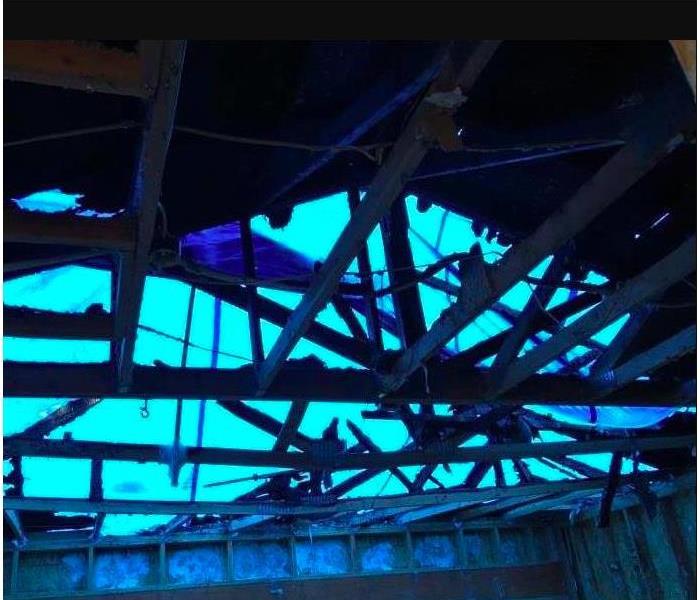 High winds from a storm caused damage to this roof.
High winds from a storm caused damage to this roof.
Before your adjuster arrives, follow these 5 steps to clean up storm damage.
After a big storm, the devastation can be significant. Your St. George, UT, property may have tree limbs down, roof damage and water damage. Whatever the case, cleanup needs to begin immediately to avoid additional damage. It's helpful to have flood insurance, especially if you live in an area prone to flooding. Many people don't realize that this is not a standard part of a homeowners policy until it's too late. It's essential to follow these basic cleanup steps until the insurance adjuster arrives.
1. Evaluate the Damage
After a major storm, there could be several types of damage, inside and outside your home. Look for water damage inside, such as soaked flooring and wet drywall. Outside, inspect for damaged or missing shingles, damaged gutters, and cracked windows.
2. Take Photos of the Flood Damage
Take photos of the damage as soon as possible. These photos will be helpful to your insurance company when you file your claim.
3. Mitigate the Loss
You must begin mitigating the damage before the storm damage restoration specialists arrive. Your flood insurance company requires you to take any action possible to avoid more damage. This could include tarping holes in the roof and boarding up broken windows.
4. Extract the Water
If you have standing water in your home, it's crucial to eliminate the water and moisture as soon as you can do so safely. Every second counts when it comes to water damage. The best way to extract it quickly is to use a wet/dry vacuum.
5. Dry the Area
The area must be completely dry to prevent mold damage. Use dehumidifiers, fans, heaters, and fresh air to eradicate the excess moisture.
After a significant storm, your flood insurance adjuster may take a while to arrive on the scene. While you're waiting, these five steps are critical in preventing subsequent loss.
Steps to Take After a Commercial Fire
5/17/2022 (Permalink)
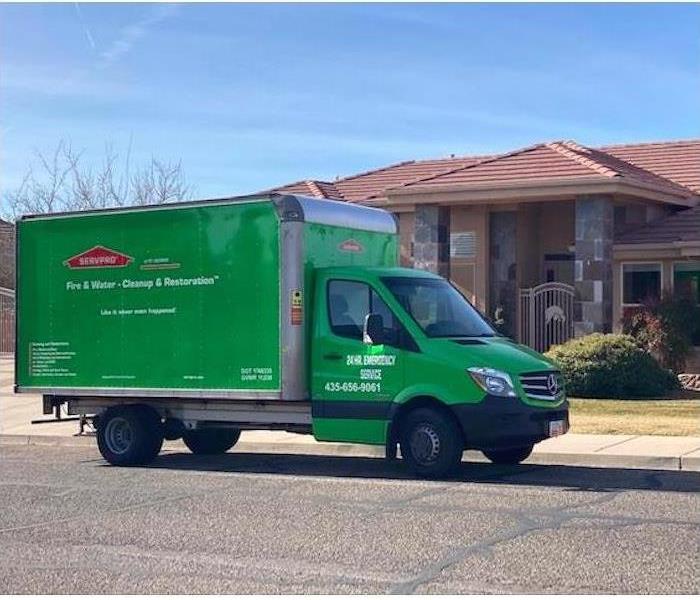 We are trained in fire damage restoration. Our team knows exactly how to cleanup soot, smoke odor and debris while restoring your property. Call us!
We are trained in fire damage restoration. Our team knows exactly how to cleanup soot, smoke odor and debris while restoring your property. Call us!
After A Commercial Fire, What Should You Do?
If there is a fire at your business in La Verkin, UT, you may be wondering what you should do. Although you should leave most of the work to fire restoration professionals, there are some things you can do right away to prevent future damage and protect your space.
1. Call Your Insurance Company
If you have fire insurance, one of your first steps should be to call the insurance company and tell them about the fire. This will help get the ball rolling for filing a claim, and the company can guide you as to what you need to do to help with compensation.
2. Call a Professional Fire Restoration Company
The damage from a fire is usually extensive, and a fire restoration company knows exactly what to do to minimize damage, clean up debris and begin the restoration process such as smoke cleaning and replacing structural components.
3. Document the Damage
In order to get fair compensation from the insurance company, you need to document your losses. Take pictures of the damage but do not touch any of the damaged items. Make sure you keep receipts of any purchases related to clean up, repairs and restoration and keep track of estimated loss of business income as a result of the fire.
4. Board Up the Exterior
Unfortunately, some people use other's misfortune for their gain. If the fire caused damage to exterior structures, this makes it easier for thieves and vandals to enter. Make sure you board up doors, windows and the roof. You may also want to hire private security to patrol the building until the restoration process is complete.
It can be confusing after a fire. However, the sooner you take steps to protect your business, the less overall damage will occur. Hire fire restoration services right away and protect your business the best ways possible.
A Fire Also Means Dealing With Water Damage
5/17/2022 (Permalink)
Water Damage From A Fire
A fire in your Ivins, UT, business means much more than just dealing with fire damage. Considering that a typical fire hose is capable of releasing 500 gallons of water per minute, even a small fire means a business is being drenched by thousands of gallons of water.
Water Damage After a Fire
Once the flames are extinguished, the cleanup process will require addressing damage from both the fire and water. A thorough inspection of the damage will be needed. Typically, a business may expect to have to address the following areas:
- Mold: When there is water, there is an increased risk of mold growth. Mold starts forming within 24 hours.
- Wood: From floors to furniture, wood quickly absorbs moisture. Any signs of buckling and warping indicate a replacement will be needed.
- Drywall: It is likely that the walls took the brunt of the water, which means replacing drywall. While some may be salvageable, it may also be a prime location for mold to grow.
- Electronics: Soot, smoke and water have negative effects on electronics. Depending on the damage, these items will likely need to be replaced.
Get Expert Help
After a fire, the situation may easily seem chaotic. Luckily, a professional fire damage restoration will have the expertise to address both types of damage. A certified service provider will have highly trained professionals and specialized equipment to eradicate mold growth, repair damage from the fire and water and get your property back up and running quickly. Along with the peace of mind of having a one-stop shop, established mediation companies also are well-versed in the insurance world and work to help ensure the claim process goes smoothly.
Dealing with the aftermath of a business fire doesn't just involve fire damage. It also comes with water issues. Getting professional help for the cleanup makes it easier and faster to get back on track and have both issues resolved.
What to Do About Smoke Odor Damage
5/17/2022 (Permalink)
How To Deal With Smoke Damage
If you have experienced a fire in your commercial space in Enterprise, UT, you have a lot to deal with. Although the fire probably caused a lot of structural damage, another effect that can cause lots of issues is smoke odor. It is important to conduct smoke cleaning as soon as possible to minimize the damage.
Initial Steps to Take
Waiting to deal with smoke odor is a mistake, as the
longer it is there, the more it seeps into fabrics and carpeting, which makes it almost impossible to get rid of completely. Some of initial steps you should take include:
- Introduce fresh air into the space by opening windows and doors and using fans to help direct the smoke particles out
- Call for professional fire restoration services, as they have the special devices and machines designed to deal with smoke damage, no matter how big of space the fire ruined
- Make a solution of a half cup of white vinegar, gallon of warm water and a teaspoon of dishwashing liquid to wipe down hard surfaces such as doors, window sills, desks and chairs
How the Professionals Handle Smoke Cleaning
Although you can do some things that may mitigate the fire damage, professional cleaners have the tools necessary to get the terrible smell out of the air, carpet and furnishings. Some of the tools at their disposal include ozone machines, which help break down odors, and thermal foggers, which distribute small particles to be able to target smoke particles in tiny cracks and surface pores. Professionals also use commercial air filtration devices that contain carbon and HEPA filters for smoke cleaning.
Damage caused by smoke can be challenging to completely get rid of if you do not address the problem right away. Along with your efforts, a professional team can remove the odors from all types of surfaces.
5 Types of Leaks That Are Causing Your Water Bill To Spike
4/26/2022 (Permalink)
5 Types Of Leaks That Are Increasing Your Water Bill
You've noticed that your water bill, which is usually pretty stable, has suddenly spiked and keeps climbing. You haven’t hired a ton of new employees, and you haven't done anything different with the irrigation schedule, so what gives? Here are five ways a water leak could be causing a spike in your water bill.
1. Outdated Fixtures
If you bought an older building and didn't replace the toilets or faucets, one of these could be the problem. Older fixtures are less efficient and usually mean older pipes, so a sudden climb in your water bill could mean that the pipes are blocked or that there is a water leak.
2. Problematic Irrigation
An irrigation system is a time-saver, but it can be costly when it breaks. Check for a pipe break or a faucet head that is cracked. If your system is buried, look for unusually soggy patches of ground.
3. Running Toilets
A running toilet can waste thousands of gallons of water and drive your bill sky high. It's easy to check to see if a toilet is running and is often a pretty easy fix. However, if you have a running toilet that is outdated and the hardware store fix didn't make a difference, you may benefit from calling a water damage specialist to investigate whether a pipe break or a leak is contributing to the problem.
4. Leaky Faucets
Similar to running toilets, a leaky faucet can cost you a lot of money. Even little drips add up and often continue to get worse until the actual faucet is fixed.
5. Cracked Lateral Line
The costliest possibility is that there is a cracked lateral line (the line that feeds water into your business). That means the water is leaking out before it gets to you. If you're suspicious that this is the problem, contact a professional for an assessment.
A water leak from a pipe, a running toilet, or a cracked irrigation line can drive up your water bills. When you have unexplained water costs, investigate promptly to save your business money and resources.
3 FAQs About Homeowner’s Insurance and Water Damage
4/19/2022 (Permalink)
3 Commonly Asked Questions About Homeowners Insurance And Water Damage
There has been a lot of water lately in Washington, UT. This has brought up a lot of questions about insurance. Most people want to know if their policy will cover a flood, burst pipe, or other issues. If it is not, they could be spending a lot of money to fix broken pipe fittings and other parts, clean up water, and replace their personal belongings. Here are some of the most frequently asked questions and their answers.
1. Does Insurance Cover Burst Pipes?
Homeowner's insurance does cover the damage from a flood caused by a burst pipe. However, this is only true if the pipe burst suddenly due to unforeseen circumstances. For instance, if an appliance breaks and water comes gushing into your kitchen, this will be covered. The insurance will pay for you to hire water remediation professionals and replace your damaged items in situations like this. However, if the pipe bursts due to poor maintenance, you will probably not receive any funds.
2. Are Frozen Pipes Covered?
Your insurance will only cover frozen pipes if you have taken reasonable steps to prevent freezing. This is because each situation is unique. Plus, there is room for interpretation in this statement. Your insurance company will send out an adjuster to determine if you are eligible. They will look at the source and determine if the damage could have been prevented. That means that any insulation or preventative measures you provide for your plumbing will work in your favor.
3. What Happens When There Is Flooding in a Home?
Damage caused by excessive groundwater or storms is generally not covered. In these cases, you would need a separate flood insurance policy to pay for the damage.
Your insurance coverage can have a lot of limitations when it comes to water damage. To properly protect yourself, you need to know what your policy covers and take any measures to increase your chances of receiving funds.
3 Facts That Will Make You Want Flood Insurance
4/13/2022 (Permalink)
Three Factors That Will Influence Your Decision To Purchase Flood Insurance
Business owners from high-risk flood zones have probably seen commercial insurance policies that offer protection against natural disasters. Meanwhile, many business owners in St. George, UT, do not understand this option's importance. These people are too worried about the cost of the policy, which can range from a reasonable FEMA policy to a high-end private one.
They often overlook the fact that a flood can cause excessive damage that needs to be restored by a storm remediation company. If you are in this boat, some facts may convince you that flood insurance is a good idea.
1. Property Insurance Doesn’t Cover Flooding
Even commercial insurance only covers damage from rainwater that has not touched the ground. For instance, if a tree goes through your roof while a storm rages and rainwater ruins your floor, it is covered. Once water hits the ground, it becomes a flood and is no longer covered. In other words, a rising creek caused by rain is not covered. Only flood insurance will cover this type of situation.
2. Every Business Is at Risk of Flooding
Rather than if, you should ask how much flood risk you have. The national flood maps can give you an idea of your exact risk. Certain zones are high-risk. Others are medium- or low-risk. Remember that low does not mean no. You are still at risk for flooding in low-risk zones.
3. Government Aid Is Not Insurance
Unlike commercial insurance, government aid is primarily loans that you'll need to repay. Plus, you cannot receive aid unless your area is federally declared a disaster zone, which happens for only a few major flooding events.
Unfortunately, standard insurance doesn't cover flooding. To protect your business, you'll need a flood policy. To make things worse, you can't rely on government aid for your company. These are simply loans that you will need to pay back. Plus, you can't always receive these loans.
Since every business is in a flood zone, proper insurance is a must. This ensures that any damage you incur to do a flood is covered.
What Should Adjusters and Clients Look For In a Restoration Service?
3/16/2022 (Permalink)
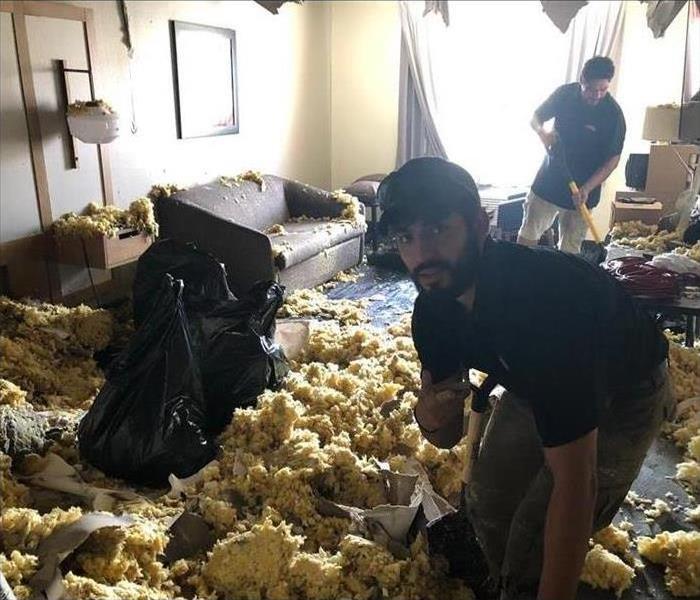 Insurance agents and adjusters can access claim information and estimates online at any time through the SERVPRO Claims Information Center.
Insurance agents and adjusters can access claim information and estimates online at any time through the SERVPRO Claims Information Center.
What Should Clients And Adjusters Look For In A Restoration Company?
When it comes to damage restoration, an insurance adjuster and client share many interests. Both want to have mitigation and restoration work done well at a reasonable cost. Insurance representatives and property owners should look for the following features when comparing restoration services in Ivins, UT.
Accurate Estimates
An estimate gives clients and insurers a clearer sense of the total amount of an insurance claim. This calculation should account for several aspects of a job:
- The type and extent of damage
- Necessary equipment and labor
- Mitigation and restoration costs
A company that provides both mitigation and restoration services may provide a more accurate initial estimate. An insurance adjuster is likely to prefer a single estimate that accounts for the entire process rather than two estimates from different companies that may or may not work together.
Ease of Access
Insurance agents and adjusters can access claim information and estimates online at any time through the SERVPRO Claims Information Center. This service provides a variety of information:
- Claim information
- Estimates
- Comparison data
Insurance representatives can sign on to review updated information about a job. This electronic claims service also enables insurers to compare national, regional, state, county or local data on claims, losses and jobs.
Industry-Leading Methods
Insurance representatives and clients can both appreciate a service that uses cutting-edge methods. Certification from the Institute of Inspection Cleaning and Restoration indicates that a company adheres to established industry-wide best practices. This credential often means that a service can complete a job in less time and often with a lower claim.
An insurance adjuster is more likely to settle a claim based on an accurate estimate from a company capable of completing the job. The availability of claim information can make this process faster and more straightforward. An insurer or client can access all of these features through a SERVPRO location in Ivins, UT.
Preparing Your Commercial Property for Extreme Winter Weather
3/5/2022 (Permalink)
Getting Your Commercial Property Ready for Winter Storms
Nowadays, you have access to a wealth of information right at your fingertips, so there’s no reason for the weather in Hurricane, UT, to take you by surprise. The more uncertain matter is what to do in preparation for extreme weather once you know it’s on the way. A heavy downpour or snow storm could still cause problems, but a bit of planning may make things less difficult for your commercial property and the people who use it.
Stock the Necessities
The buildings you own and manage should be outfitted with emergency kits in case anyone is stranded, especially if the power has gone out. Their cases should be easy to move and well-stocked. There are some recommended items to include:
- Food and water
- Supplies for basic first aid
- Flashlights with extra batteries
- A whistle
Keep Your Building in Shape
The property itself should also be well-maintained to improve its safety in a snow storm. If the structure of the roof is prone to collecting water and snow, hire a contractor to fix it and prevent collapse. Ensure that the walls are well-insulated. Be prepared to turn off the water valves if there’s a pipe burst. In extremely cold conditions, it’s vital to have an alternate heat source on hand, such as a fireplace or extra blankets.
Consider Your Employees
One of the best ways to make an emergency situation easier is to prevent one from arising in the first place. If you run a business and see an ominous forecast on the news, consider having your employees stay home for the day until it’s safer to travel. If remote work is an option, it may be wiser to have your staff work from home instead of coming into the office.
If your building suffers damage from a snow storm despite your preparations, a professional service can help clean up, restoring safe conditions and allowing business to carry on as usual in a timely manner.
3 Reasons Insurers Trust Preferred Vendors
3/2/2022 (Permalink)
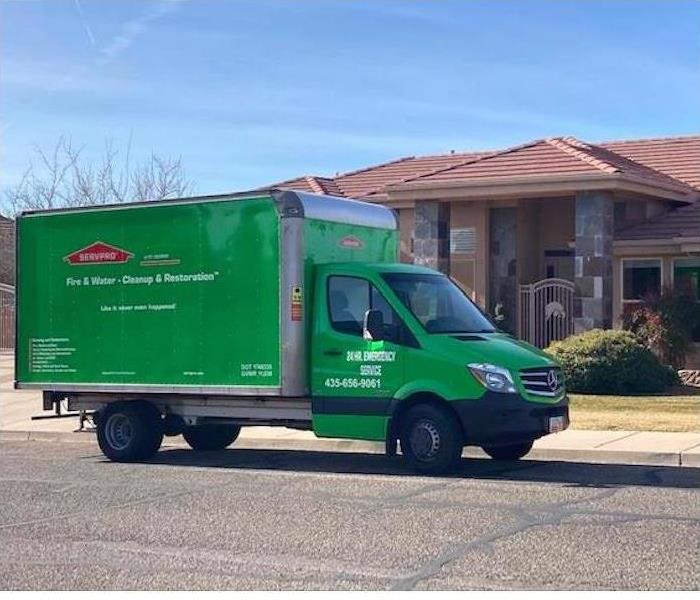 In order to obtain referrals for insurance claims, a SERVPRO franchise must meet internal corporate standards
In order to obtain referrals for insurance claims, a SERVPRO franchise must meet internal corporate standards
Insurers Trust Preferred Vendors For Three Reasons
Insurance companies tend to work with mitigation and restoration services that have a track record of successfully completing jobs. An insurance agent will be more likely to approve a claim supported by an accurate estimate and easy access to important information. Here are three reasons why insurers trust Preferred Vendors.
1. Rigorous Operational Standards
In order to obtain referrals for insurance claims, a SERVPRO franchise must meet internal corporate standards. The Participation Agreement sets forth 21 guidelines for franchises. Locations in the vendor program must perform background checks, maintain insurance and meet other requirements necessary for achieving the highest service standards.
2. Accurate and Reasonable Estimates
Preferred Vendors also tend to provide more accurate estimates. Increased accuracy may be possible through pretesting or a careful on-site inspection. A franchise uploads information to an internal database. An insurance agent or adjuster can then sign onto an electronic claims service to access estimates and other information at any time. The accuracy and availability of this information sets the best mitigation and restoration firms apart.
3. Ability To Meet or Exceed Expectations
Leading vendors tend to have a history of successful jobs. Even if a franchise location is new, the owner and employees should have IICRC certification and training that enables them to effectively perform mitigation and restoration procedures. Agents and adjusters can assess the performance of any location with information available on the Claims Information Center. In addition to estimates and details on individual claims, this service also makes it easy to compare factors such as job file costs and response times.
All of these factors distinguish Preferred Vendors from other options in St. George, UT. An insurance agent or client should make sure that a local SERVPRO franchise participates in the vendor program. These credentials make it more likely than an insurance claim will be processed and settled in a timely manner.
Step By Step: Combining Mitigation and Restoration
2/19/2022 (Permalink)
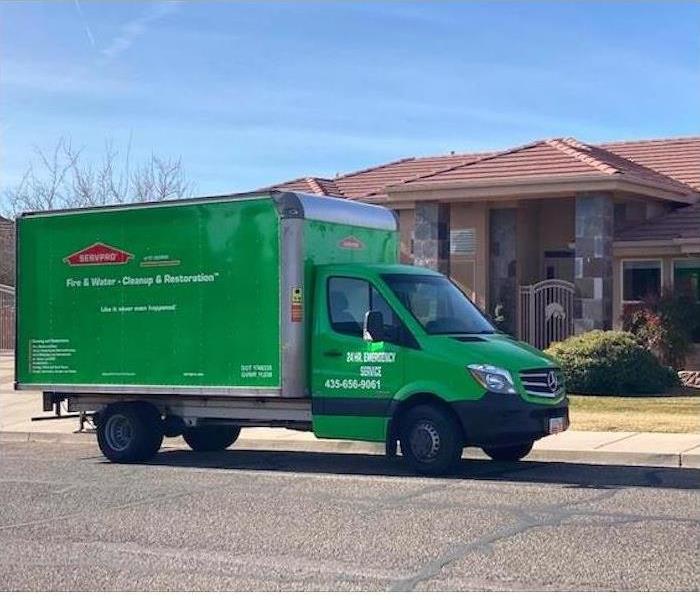 A water, fire, or mold damage event can occur when you least expect it and cause devastating damage to your home or business. Call SERVPRO for help!
A water, fire, or mold damage event can occur when you least expect it and cause devastating damage to your home or business. Call SERVPRO for help!
Mitigation and Restoration: A Step-by-Step Approach
A house fire can cause extensive problems. Not only is there the damage from the fire itself but also there is likely water damage from the efforts to put the fire out. It's a good idea to choose certified remediation specialists that handle both damage mitigation and fire restoration. Just one call connects you to a company in Washington, UT, that can handle the process from the first step to the last.
1. Company Contact
When you call, a dispatcher in the corporate call center contacts a local franchise to initiate your fire rebuild. House fires don't keep to a convenient schedule. With 24-hour service, you don't have to wait until traditional business hours to start the process.
2. Inspection and Protection
When the technicians arrive at your home, they walk through to assess the damage. This gives them the information they need to plan the time, tasks and cost it will take to complete the fire restoration process. They can also board up the vulnerable areas of your home so that no further damage or theft occurs.
3. Water Extraction
Removing excess water is the first priority. To prevent secondary damage, such as mold growth or further deterioration of walls and floors, the affected area must be dried as soon as possible.
4. Cleaning
Soot and smoke residue must be removed from all surfaces. Rebuilding services also include disinfecting items that can be salvaged before they are returned to your home.
5. Restoration
Once the damage is removed, repairs begin. Floors can be fixed with new tile or carpet. Ceiling tiles are matched and replaced. New drywall is added, and the walls are painted to match the remaining structure. The larger the fire, the more extensive the restoration process will need to be.
Fire restoration isn't complete until your home looks "Like it never even happened." By hiring skilled technicians who handle both mitigation and restoration, you can there more quickly.
4 Tips for Space Heater Safety
2/14/2022 (Permalink)
4 Safety Tips For Space Heaters
Nothing is cozier than a little extra warmth on a cold night, but the peril of a burned space heater can turn relaxation into aggravation in a hurry. Many fires in St. George, UT, are started every year by space heaters, and these fires could have been avoided if the owners used the heaters correctly. Here are four tips for getting extra warmth without extra worry.
Placement
Portable heaters are designed for a specific type of placement. There are several criteria to consider when choosing a surface for your heater. The surface should be:
- Non-flammable
- Level
- Stable
- Near an outlet
Any device that generates heat should sit on a surface that can withstand it. Place it on the floor rather than on a table so that it is less likely to be knocked over. It should also be near enough to an electrical outlet that plugging it in does not stretch the cord.
Power
The simplest way to avoid a burned space heater is to turn it off when it’s not in use. It also helps to purchase one with an automatic shut-off feature in the event that it gets turned over or accidentally covered up. Make sure the power outlet is not overloaded, and the cord is intact.
Preservation
Proper maintenance is important for safety. Your space heater should never be used when its filter is dirty. If filter lint catches fire, you are going to need smoke cleanup from fire restoration professionals. Clean or change the filter regularly.
Proximity
Your heater needs both space and attention. Keep pets and children at least three feet away from it. It should not be used near anything flammable. Only keep the space heater on while you are in the room with it.
A burned space heater can cause damage to your home and negate the relaxed atmosphere it is intended to create. By following these safety tips, you can enjoy the warmth without the stress.
Three Things You Should Know About Water Damage
2/7/2022 (Permalink)
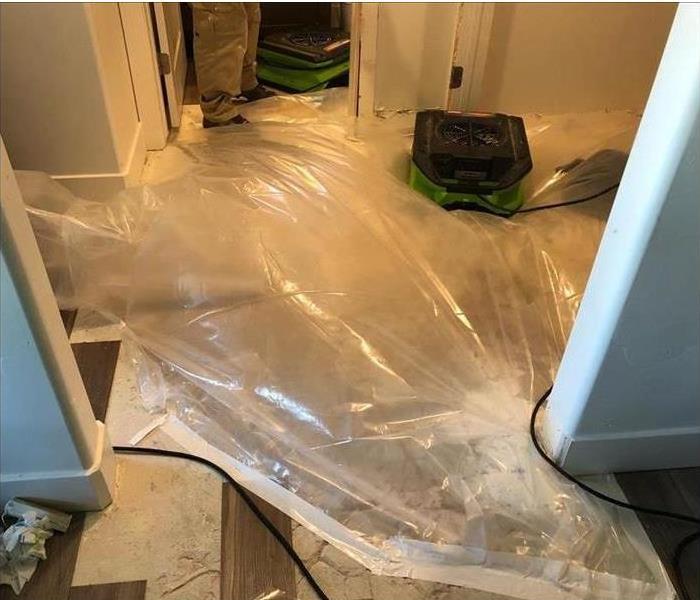 At SERVPRO we can repair both the water source in your home and the resulting damage. If you notice water in your home, do not hesitate to call us.
At SERVPRO we can repair both the water source in your home and the resulting damage. If you notice water in your home, do not hesitate to call us.
Water Damage: Three Things You Should Know
Water from a storm or pipe burst is often the cause of home damage, but it is likely that you don’t know all there is to know about this common problem. Here are a few things to keep in mind in the event of water damage to your St. George home.
1. It Can Come From a Variety of Sources
There are many things that can cause water damage. In the winter, frozen pipes can break, and snow or ice can cause damage to your roof and create a leak. A broken water line can also cause quite a bit of damage. Water can also come from a smaller source, such as a leaky pipe or cracks in the walls.
2. It Is Not Always Covered By Homeowners Insurance
Depending on the source of the water damage, you will not always be covered by your insurance. One example is if you have failed to maintain your home properly and a broken pipe or appliance is found to be caused by negligence. Another instance when you will generally not be covered is if the damage is caused by flooding. Most homeowners policies do not cover this type of natural disaster, and you will need to have a separate flood policy.
3. It Can Cause Significant Damage
Even if the source of damage seems insignificant, you should have it dealt with right away. A leaky window may not be as much of an emergency as having a pipe burst, but if it is ignored, the water damage will only worsen. Water can cause building materials to warp and can contribute to the growth of mold inside of your walls and flooring, so it should be taken care of as soon as you notice it.
Whether a pipe burst or a leaky roof has let in moisture, a professional water damage remediation service can help. They can repair both the source of water in your home as well as the resulting damage. If you notice water in your home, do not hesitate to get it fixed.
3 ways to protect a company from fire
1/14/2022 (Permalink)
3 Strategies To Keep A Business Safe From Fire
Fires can swiftly destroy property and pose a threat to occupants in a commercial building. Here are three fire preparation measures that building owners and occupants can take to protect any business from fire.
1. Arrange For a Fire Hazard Analysis
A disaster preparation expert can perform an analysis of fire hazards in a structure. Risks may include combustible building materials, improper handling of flammable contents, or a lack of functional alarm and suppression systems. A hazard analysis can help building and business owners develop more practical fire safety and evacuation plans.
2. Test Alarm and Fire Suppression Systems
Every commercial structure should be equipped with operational fire detection and suppression equipment. For fire preparation purposes, smoke or fire detectors should be tested monthly and sprinkler system inspections should occur at least once a year or as needed.
Make sure that detection devices have a reliable primary and backup power source and are designed to function in the most useful ways for the purpose of the structure. Sprinklers should be functional and arranged to correspond to the current usage of a facility.
3. Perform Drills and Post Emergency Information
Occupants will need to practice evacuating from a structure at least twice a year. Be sure to inform new employees about fire safety policies, and post emergency information throughout the structure for the benefit of guests. Ensure that every occupant is aware of primary and secondary evacuation routes and knows not to use elevators in the event of a fire.
These measures can help to protect a commercial property and the occupants of a structure from fire. Fire preparation should be a consistent effort to ensure that building occupants will know what to do when a fire breaks out. A building owner or manager should maintain access to contact information for insurers and a fire damage mitigation company in St. George.
4 things to avoid doing after water damage
1/14/2022 (Permalink)
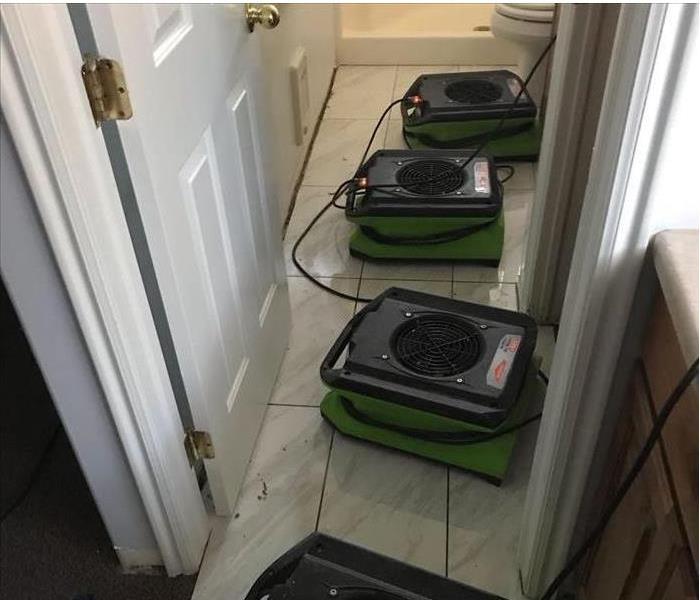 Homeowners may be unsure of what to do after water damage due to a burst pipe or any other cause, at SERVPRO, we can help.
Homeowners may be unsure of what to do after water damage due to a burst pipe or any other cause, at SERVPRO, we can help.
After water Damage, There Are Four Things You Should Avoid Doing.
Homeowners may be unsure what to do after a residence suffers water damage from a broken pipe or any other cause. The most important measures include eliminating standing water, cleaning and disinfecting the area if necessary, and promoting drying. There are four things homeowners should avoid doing to limit damage and personal risk.
1. Allowing Water To Stand
Standing water can severely damage any structure. Water left standing will also become more contaminated. Clean Category One water emitted from a broken pipe can degrade to contaminated Category Two gray water within 48 hours. Contaminated water in home requires disinfection, whereas Category One damage can simply be dried.
2. Encountering Electrical Hazards
The risk of electrocution increases if a leak takes place near electrical fixtures, plugged-in appliances, or electrical wiring. The best way to limit this risk is to shut off the power at a breaker box. If water damage is present near this panel, contact the power company or an electrician.
3. Exposure To Contaminated Water
Heavily contaminated Category Three black water from a sewer backup or flooding may contain solid waste and other potentially dangerous substances. Even Category Two water may contain microbes or chemicals. It is advisable to wear personal protective equipment or hire water damage cleanup professionals.
4. Maintaining High Moisture Levels
High moisture levels that persist after any category of water damage will increase the risk of mold growth. Fungi require nutriment and moisture in order to thrive. Run a dehumidifier to lower moisture levels in the air and dry out porous materials.
It is important to avoid doing these things after discovering a broken pipe or another source of water damage in a home in Washington, UT. Each of these factors contributes to property damage or personal risk. The best way to avoid these factors is to contact a water damage mitigation and restoration service.






 24/7 Emergency Service
24/7 Emergency Service













